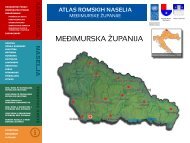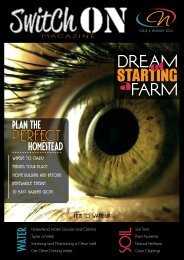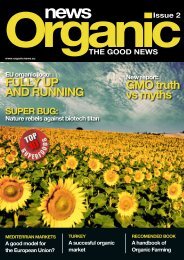Organic News 3
Organic News magazine issue 3
Organic News magazine issue 3
You also want an ePaper? Increase the reach of your titles
YUMPU automatically turns print PDFs into web optimized ePapers that Google loves.
6. Predatory Bugs (Hemiptera)<br />
This group includes big-eyed, minute pirate, assassin,<br />
damsel and even certain predatory stink<br />
bugs. All use their mouth, or “beak,” to pierce and consume<br />
prey. Adults range in size from the minute pirate bug (onesixteenth-inch<br />
long) to the wheel bug (an assassin bug that’s 1<br />
1/2 inches long). Diet: Nymphs or larvae and adults feed on<br />
aphids, caterpillars, scale insects, spider mites and insect eggs.<br />
Many also prey upon beetles.<br />
7. Soldier Beetles (Coleoptera)<br />
These elongated, half-inch-long beetles have soft<br />
wing covers. Larvae are brownish and hairy.<br />
Adults usually have yellow or red and black markings and<br />
resemble fireflies. Diet: Larvae feed on the eggs and larvae of<br />
beetles, grasshoppers, moths and other insects. Adults feed on<br />
aphids and other soft-bodied insects, as well as on nectar and<br />
pollen.<br />
8. Spiders (Araneae)<br />
All of the more than 3,000 North American species<br />
— including the crab spider, jumping spider,<br />
wolf spider and orb-web spider — are predatory. Diet: Depends<br />
on species, but can include aphids, beetles, cutworms,<br />
fire ants, lacebugs, spider mites, squash bugs and tobacco<br />
budworms.<br />
9. Tachinid Flies (Diptera)<br />
There are more than 1,300 North American species<br />
of parasitic flies. Most resemble houseflies<br />
but with short, bristly hairs on the abdomen. All develop as<br />
internal parasites of other insects, including many garden<br />
pests. Usually, the adult female attaches its egg to the host<br />
insect, which is then consumed by the larva, but there are several<br />
other patterns: eggs laid on host, eggs laid into host, eggs<br />
laid on foliage to be eaten by host, live larvae laid on or near<br />
host, and live larvae laid into host. Diet: Larvae feed internally<br />
on caterpillars, beetles, bugs, earwigs and grasshoppers. Adults<br />
feed on nectar, pollen and honeydew.<br />
54<br />
WWW.ORGANICNEWS.EU






